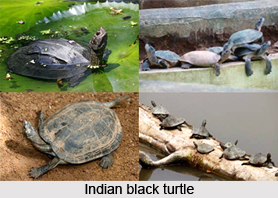 Indian Black Turtle is an Indian Reptile that bears a scientific name "Melanochelys trijuga" or Indian Pond Terrapin is a species of turtle found in South Asia. It is also known as Hard Shelled Batgun Terrapins.
Indian Black Turtle is an Indian Reptile that bears a scientific name "Melanochelys trijuga" or Indian Pond Terrapin is a species of turtle found in South Asia. It is also known as Hard Shelled Batgun Terrapins.
Description of Indian Black Turtle
Indian Black Turtle is classified as near threatened in IUCN red list. It is particularly threatened by hunting for its meat which is considered as delicacy and due to pet trade.
Size of Indian Black Turtle
Indian Black Turtle is a medium-sized fresh water turtle. The size may vary from 38 -45 cm in length.
Colour of Indian Black Turtle
Despite its name the colour of its upper shell or carapace varies largely from reddish to dark brown and black with yellow streaks running along its length.
Plastron of Indian Black Turtle
The underside or plastron of Indian Black Turtle is uniformly brown in colour. The face of Indian Black Turtle may have yellow or orange marks and spots with the colour of these marks varying form 1 sub species to another. It has 6 identified sub species in the Asian region, each having somewhat different pattern of spots on head.
Concentration of Indian Black Turtle
Indian Black Turtle is found in the Northern part of Bangladesh, Central part of Myanmar, Sri Lanka, Maldives, Chagos Islands and Nepal. They are also found in Assam, Meghalaya, Shillong, Gawahati and the forests of Kaziranga National Park. They are also found but in minimum quantity in Chagos Archipelago in the Indian Ocean.
Habitat of Indian Black Turtle
Indian Black Turtle is most active during early morning and evening. It spends the day basking in the sun.
Forage of Indian Black Turtle
Indian Black Turtle typically forages on aquatic vegetation along the edge of water bodies. It is omnivorous and its diet ranges from aquatic plants to aquatic insects and even to carcasses of dead animals. Some times many turtles can be seen alongside a carcass of a large dead mammal. The Sri Lankan subspecies spends its days in burrows during day time having a flatter carapace consequently.
Distribution System of Indian Black Turtle
Indian Black Turtle inhabits a variety of water bodies including ponds, marshes streams, rivers and artificial water bodies like Rice paddies, watering holes etc.
Breeding of Indian Black Turtle
Indian Black Turtle breeds during the wet season between August and October. During this time the male becomes particularly aggressive and starts chasing the female all the while biting her along the neck, the male attaches itself on the top of female during mating. Once the mating is completed the female digs a nest in the ground or occasionally in a pile of rhinoceros or elephant dung using the left hind leg to excavate the nest and right hind leg to clear the excess material.
Eggs of Indian Black Turtle
The clutches of eggs are laid into this burrow. 2-6 clutches are laid in a burrow per year.
Incubation of Indian Black Turtle
The incubation period of eggs of Indian Black Turtle is about 60-65 days and the newborns are hatched around the summer season.



















